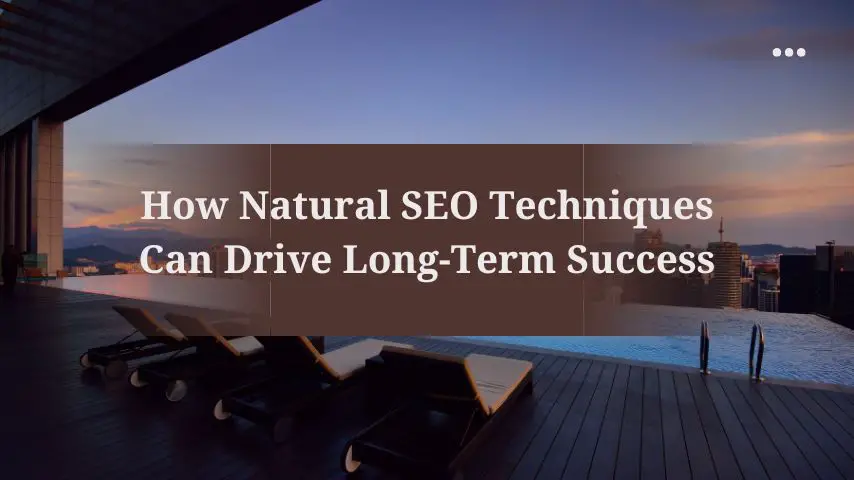In today’s digital world, businesses strive to build a strong online presence, and search engine optimization (SEO) plays a crucial role in this endeavor. While many SEO tactics promise quick results, natural SEO techniques, often referred to as “white-hat SEO,” offer sustainable, long-term benefits. This article delves into the importance of natural SEO techniques, how they work, and the steps businesses can take to implement them effectively.
What Are Natural SEO Techniques?
Defining Natural SEO
Natural SEO refers to organic methods of optimizing a website to rank higher in search engine results. Unlike black-hat techniques, which aim to manipulate search engines, natural SEO focuses on improving a website’s quality, relevance, and user experience. Search engines like Google have sophisticated algorithms that reward websites using ethical, user-focused techniques.
Why Is Natural SEO Important?
Natural SEO offers lasting results. While it may take longer to see an impact compared to paid or black-hat strategies, the benefits are sustainable. Websites that invest in natural SEO are less likely to be penalized by algorithm updates, and their rankings are more stable. Moreover, natural SEO improves the overall user experience, leading to higher engagement and conversion rates.
The Key Elements of Natural SEO
To better understand how natural SEO works, let’s look at some of the main components that contribute to its success:
1. High-Quality Content
At the heart of any successful SEO strategy is high-quality content. Search engines prioritize websites that provide valuable, informative, and relevant content. High-quality content attracts visitors, keeps them engaged, and encourages them to return. Over time, this can improve the website’s authority, leading to higher rankings.
What Makes Content High-Quality?
- Relevance: Your content should be relevant to your audience and address their needs or queries.
- Accuracy: Providing accurate information builds trust with your audience and establishes you as an authority in your field.
- Readability: Content should be easy to read, well-organized, and free from spelling or grammar mistakes.
2. Keyword Research and Optimization
Keywords are the words and phrases that users type into search engines to find information. Conducting thorough keyword research ensures that your content aligns with what your target audience is searching for.
How to Use Keywords Effectively
- Focus on Long-Tail Keywords: Long-tail keywords are longer, more specific phrases that are less competitive but have higher conversion potential.
- Avoid Keyword Stuffing: Overloading your content with keywords can harm your SEO efforts. Search engines can detect this, and it can negatively affect user experience.
- Natural Placement: Keywords should fit naturally into your content without forcing them in. This ensures that your content remains readable and user-friendly.
3. Mobile Optimization
With the majority of internet users accessing websites through mobile devices, mobile optimization is no longer optional. Search engines like Google prioritize mobile-friendly websites in their rankings. Therefore, businesses must ensure their websites offer a seamless experience across all devices.
Steps for Mobile Optimization
- Responsive Design: A responsive website automatically adjusts to the screen size of the device being used, ensuring a smooth user experience.
- Fast Loading Speeds: Mobile users expect websites to load quickly. Optimize images, compress files, and minimize code to improve site speed.
- Mobile-Friendly Navigation: Simplify menus and navigation bars to make it easier for mobile users to browse your website.
4. On-Page Optimization
On-page SEO refers to the techniques used directly on your website to improve its search engine rankings. These techniques enhance both the visibility of your website and the overall user experience.
Important On-Page SEO Elements
- Title Tags and Meta Descriptions: These are the first things users see in search engine results. Crafting engaging, relevant title tags and meta descriptions can significantly improve your click-through rate.
- Header Tags (H1, H2, etc.): Properly structuring your content with header tags makes it easier for both users and search engines to understand the hierarchy of information.
- Image Alt Text: Including descriptive alt text for images helps search engines understand the content of the images, improving your SEO.
5. Backlinks and Link Building
Backlinks, or inbound links, are links from other websites that point to your website. Search engines consider backlinks as a vote of confidence in your content. The more high-quality backlinks you have, the more authority your site will gain.
How to Build Quality Backlinks
- Create Shareable Content: High-quality, engaging content is more likely to be shared and linked to by others.
- Guest Blogging: Writing guest posts for reputable websites in your industry can help you earn backlinks and increase your visibility.
- Build Relationships: Networking with influencers and other businesses can lead to opportunities for backlinks.
6. User Experience (UX)
Search engines are increasingly prioritizing websites that offer a positive user experience. Factors like site speed, mobile-friendliness, and ease of navigation all contribute to a better user experience, which in turn improves your SEO rankings.
Enhancing User Experience
- Fast Loading Times: A slow website can frustrate users, leading to higher bounce rates. Optimize your site’s speed for a smoother experience.
- Clear Navigation: Make sure users can easily find what they’re looking for. Intuitive menus and search functionality are key to keeping users engaged.
- Engaging Design: A visually appealing website that’s easy to navigate will keep users on your site longer, increasing engagement and conversion rates.
The Role of Technical SEO in Natural SEO
Technical SEO refers to optimizing your website’s infrastructure to make it easier for search engines to crawl and index your site. While it may not be as visible as content optimization, technical SEO is essential for long-term success.
Key Technical SEO Aspects
- Site Structure: A well-organized site structure makes it easier for search engines to crawl and index your website.
- XML Sitemaps: An XML sitemap helps search engines understand the layout of your website and find all the important pages.
- Robots.txt File: This file tells search engines which pages of your site to crawl and which to ignore.
- HTTPS Security: Search engines prioritize websites that use HTTPS, as it provides a secure connection for users.
The Benefits of Natural SEO for Long-Term Success
Now that we’ve explored the key elements of natural SEO, it’s important to understand the long-term benefits of adopting these techniques. While the process may take time, the advantages are well worth the investment.
1. Sustainable Rankings
Unlike black-hat SEO techniques, which may offer short-term results, natural SEO provides lasting rankings. Once your website is established as an authority in your niche, it’s likely to maintain its position in search engine results for a long time.
2. Improved User Trust and Engagement
Natural SEO techniques prioritize user experience and high-quality content. This not only improves your search engine rankings but also builds trust with your audience. A website that provides valuable information and a positive user experience is more likely to engage visitors and convert them into loyal customers.
3. Cost-Effectiveness
While paid advertising can drive traffic to your website, it requires a continuous financial investment. Natural SEO, on the other hand, requires an upfront investment of time and effort but offers long-term benefits without ongoing costs. Once your website ranks organically, you’ll continue to receive traffic without having to pay for ads.
4. Resilience to Algorithm Changes
Search engines frequently update their algorithms to provide users with the best results. Websites that use black-hat or manipulative techniques are often penalized by these updates. However, websites that follow natural SEO practices are less likely to be affected by these changes, ensuring more stable rankings over time.
Conclusion
Natural SEO techniques offer businesses a sustainable and effective way to improve their search engine rankings. By focusing on high-quality content, mobile optimization, on-page SEO, backlinks, and user experience, companies can build a strong online presence that stands the test of time. As businesses continue to invest in their SEO efforts, the long-term rewards are clear: increased visibility, higher user engagement, and cost-effective results. For businesses seeking a reliable path to success, embracing organic SEO services is the key to driving long-term growth and resilience in a competitive digital landscape.
FAQs:
1. What is natural SEO, and how does it differ from other SEO techniques?
Natural SEO, also known as organic or white-hat SEO, focuses on optimizing a website using ethical, user-centric methods that align with search engine guidelines. Unlike black-hat techniques, which manipulate search engine algorithms for quick results, natural SEO emphasizes high-quality content, mobile optimization, user experience, and ethical link-building. The goal is to achieve sustainable, long-term rankings that are less likely to be penalized by search engine updates.
2. How long does it take to see results from natural SEO techniques?
Natural SEO typically takes longer to show results compared to paid advertising or manipulative SEO tactics. However, the timeline can vary depending on the competitiveness of your industry, the quality of your content, and the effectiveness of your overall SEO strategy. Generally, businesses can expect to see significant improvements in search engine rankings within 3 to 6 months. The benefit is that these results are more stable and sustainable over the long term.
3. Why is mobile optimization important for natural SEO success?
Mobile optimization is critical because a majority of internet users access websites via mobile devices. Search engines like Google prioritize mobile-friendly websites in their rankings, meaning that if your site isn’t optimized for mobile, it could negatively impact your SEO performance. Ensuring fast load times, responsive design, and easy navigation on mobile devices are key factors in improving user experience and search engine visibility.






